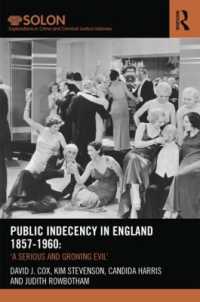Full Description
The FOX television show The Simpsons has been around for over 30 years, with more than 700 episodes. A satirical, animated comedy, The Simpsons has millions of fans around the world and its numerous characters are instantly recognizable. Two of the main characters, children Bart and Lisa, are in elementary school and their educational experience is satirized frequently, with episodes taking place at Springfield Elementary and featuring their teachers, classmates, and administration—often with biting criticism of curriculum, privatization, and standardized testing, to name a few. The Simpsons also features episodes retelling historical events, where the family experiences different countries and cultures, and participates in the political process. The Simpsons is unique in that the show itself is also a historical source, having been on the air since 1989. Issues that were current in the early 1990s at the height of popularity of The Simpsons are now considered historical, and there is room in classrooms to critically analyze the show with students about whether the show has adapted well to the 2020s, particularly with the show's use of cultural stereotypes.
This edited book offers a collection of classroom-ready tools based on the Hollywood or History? strategy and designed to foster historical inquiry through the careful use of episodes or clips from The Simpsons. This book will be organized by the 10 Themes of Social Studies as outlined by the National Council for the Social Studies (NCSS, 2010). Each of these 10 sections of the book feature two or three lesson plans from the massive catalog of The Simpsons. There is also an 11th section featuring two lesson plans using episodes of The Simpsons that satirize public education more broadly, which can be used by teacher candidates in methods classrooms to examine the realities of the history of public education and current issues that affect the profession.
Contents
Acknowledgments.
Introduction: The Longevity and Complexity of The Simpsons; Annie McMahon Whitlock.
Part I. Culture.
Chapter 1. Immigration: South Asian Stories from the Past and Present; Ritu Radhakrishnan.
Chapter 2. A Bootable Offense: Satire or Stereotype? Annie McMahon Whitlock.
Chapter 3. Whacking Away at Holiday Origins; David A. Johnson.
Chapter 4. For Further Viewing; Annie McMahon Whitlock.
Part II. Time, Continuity, and Change.
Chapter 5. History Hath a Silver Tongue: Protecting Our Ideals, or Refusing to Change? Martin Castro.
Chapter 6. Lewis and Clark's Expedition to the West; Amy Allen.
Chapter 7. For Further Viewing; Annie McMahon Whitlock.
Part III. People, Places and Environments.
Chapter 8. D'oh! Schools, Race, Segregation ... and Zip Codes? Timothy Monreal.
Chapter 9. I Don't Eat Anything That Casts a Shadow; Annie McMahon Whitlock.
Chapter 10. For Further Viewing; Annie McMahon Whitlock.
Part IV. Individual Development and Identity.
Chapter 11. You Don't Win Friends With Salad; Annie McMahon Whitlock.
Chapter 12. Ruthless Bader Ginsburgs; Annie McMahon Whitlock.
Chapter 13. For Further Viewing; Annie McMahon Whitlock.
Part V. Individuals, Groups, and Institutions.
Chapter 14. The Cause of, and Solution to, All of Life's Problems: The Simpsons and Prohibition; Jeffrey Koslowski.
Chapter 15. The Influence of Teachers' Unions Purple Monkey Dishwasher; Annie McMahon Whitlock.
Chapter 16. For Further Viewing; Annie McMahon Whitlock.
Part VI. Power, Authority, and Governance
Chapter 17. The Simpsons State of Nature; Kymberli Wregglesworth.
Chapter 18. Can't Someone Else Do It? Experience in Governing; Annie McMahon Whitlock.
Chapter 19. For Further Viewing; Annie McMahon Whitlock.
Part VII. Production, Consumption, and Distribution.
Chapter 20. Is Competition Always Good? Timothy Constant.
Chapter 21. No More PB or J for Me! Microlending on The Simpsons; Annie McMahon Whitlock.
Chapter 22. For Further Viewing; Annie McMahon Whitlock.
Part VIII. Science, Technology, and Society.
Chapter 23. STEM, Human Capital, and the Future of Work; Erin C. Adams.
Chapter 24. Trusting Every Aspect of Our Lives to a Giant Computer was the Smartest Thing We Ever Did: Are Smart Technologies Worth the Cost? Daniel G. Krutka.
Chapter 25. Well, Kids, Aren't You Glad We Don't Believe in Inoculations? Does New Media Provide More Real News? Daniel G. Krutka.
Chapter 26. For Further Viewing; Annie McMahon Whitlock.
Part IX. Global Connections.
Chapter 27. Is Anything in This Bar Made in America? Annie McMahon Whitlock.
Chapter 28. It's My First Day! The Creation of the United Nations; Annie McMahon Whitlock.
Chapter 29. For Further Viewing; Annie McMahon Whitlock.
Part X. Civic Ideals and Practices.
Chapter 30. Springfield and the History of American Immigration; Anthony Salciccioli.
Chapter 31. Down With Homework! Annie McMahon Whitlock.
Chapter 32. For Further Viewing; Annie McMahon Whitlock.
Part XI. Commentary on Public Education.
Chapter 33. Here's Your Scientifically Selected Career; Tiffany Craigie.
Chapter 34. Why Do We Take So Many Tests? The Pros and Cons of High Stakes Testing in the United States; Scott L. Roberts and Kate Van Haren.
Chapter 35. For Further Viewing; Annie McMahon Whitlock.
About the Authors.








